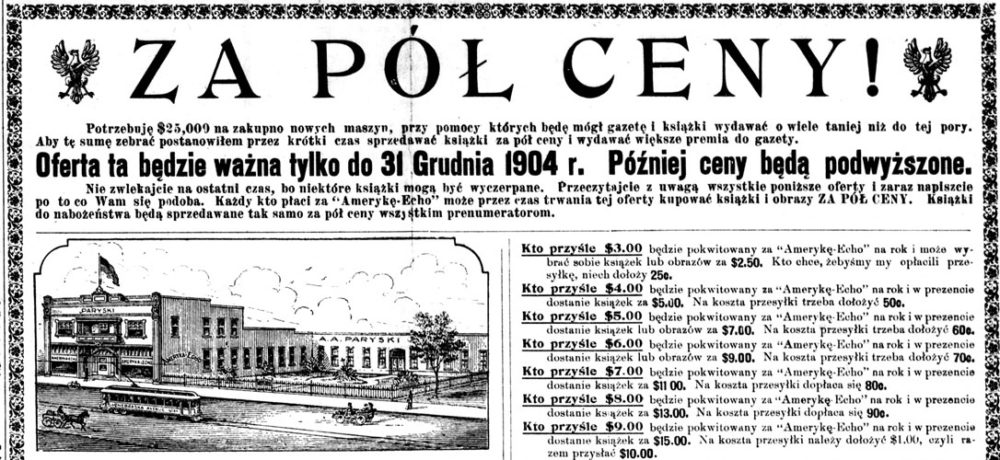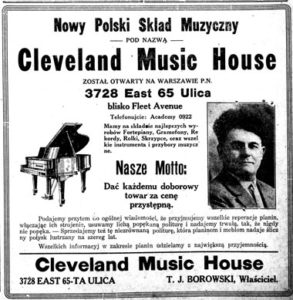Polish Newspapers Now on Chronicling America!

During the late 19th and early 20th century, Ohio saw a wave of immigration from countries in eastern Europe. Many moved to the United States in search of new opportunities that would allow them to improve their economic situation and escape hardship in their native countries. Among these newcomers were immigrants from Poland, who mostly settled in industrial cities along Lake Erie where they obtained jobs in factories and stone quarries. From 1910 to 1920, Ohio’s Polish population grew from under 10,000 to about 68,000. Toledo was a center of Polish population in America by the turn of the 20th century, and the Polish comprised Cleveland’s largest ethnic group during the early 20th century. There are still nearly half a million Ohioans who identify as being Polish or of Polish descent.
As more Poles arrived in Ohio and other parts of the United States, they established their own neighborhoods, churches, businesses, community organizations and newspapers, which helped them both preserve their native language and culture and build connections to their new homes. To help tell the story of this important ethnic group and their contributions to Ohio history, we have added the following Polish-American newspapers to Chronicling America, where they are freely available and full-text searchable (in Polish):

- Cleveland Jednośc Polek, 1923-1931
- Toledo Ameryka Echo series, 1889-1906
The Jednośc Polek (“Unity of Polish Women”) was established in 1923 as the official organ of the Association of Polish Women of the United States of America. This Cleveland-based group established a number of programs and projects on behalf of the local Polish-American community, including an insurance fund; a scholarship fund; Polish language and heritage classes; choirs and bowling clubs; and various charitable projects. Their weekly newspaper documented the administration, events and good works of the Association of Polish Women of the United States of America, and also reported on local, state, national, and international news and politics, publishing regular bulletins from Poland. Those interested in Cleveland and its environs could find business and personal sales advertisements and announcements about local events, meetings, weddings, deaths, and more. Religion was an important aspect of Polish culture and communities, so the Jednośc Polek often included local, national, and international news regarding the Roman Catholic Church. It also printed serialized fiction, poetry, and humor items. Nearly all content was in Polish, with occasional articles in English.


In Toledo, the Polish-American paper of record was the Ameryka Echo, established in 1889 by Antoni Alfred Paryski, a Polish immigrant. The Ameryka Echo grew to be one of the most successful and widely-distributed Polish publications of its time. Circulation of its many editions reached 120,000 by the 1920s, and it was distributed across the United States, in both urban and rural communities, as well as to Poland and other countries Poles immigrated to. Unlike many of its contemporaries, the Ameryka Echo was independent in politics and not tied to a particular community or fraternal group. It was liberal, supported the American labor movement, and was anticlerical (although not necessarily anti-religious), in opposition to the Roman Catholic establishment that was influential in the Polish community.
Paryski was a proponent of Polish Positivism, a movement emphasizing the importance of self-education and learning from others in the community in order to improve and strengthen the Polish nation. To this end, the Ameryka Echo encouraged readers to contribute their thoughts and opinions, which would be published in correspondence sections. The scope of these letters was wide, covering religion, immigration, Americanization, daily life and other topics. The newspaper featured a variety of literary material, including poetry, folk literature and English works in translation, and like traditional newspapers, it also included news of the day from local, national and international sources, alongside local business advertisements.
Both of these newspapers represent only a small part of Polish-American and Polonia (Polish diaspora) history. There are other Polish-language newspapers that have been digitized for Chronicling America and a number of institutions across the United States hold hardcopy and microfilm editions of even more newspapers documenting the Polish community. These newspapers provide insight into the history and culture of Polish-Americans in their own words. Even if you can’t read Polish, we encourage you to explore these newspapers (there are many online tools you can use to translate content into English) to learn more about what it was like to be Polish in Ohio, and the United States, during the late 19th and early 20th centuries.
Further reading:
- Identify, Conflict, and Cooperation: Central Europeans in Cleveland, 1850-1930 edited by David C. Hammack, Diane L. Grabowski and John J. Grabowski (2002)
- The Polish Hearst: Ameryka-Echo and the Public Role of the Immigrant Press by Anna D. Jaroszyńska-Kirchmann (2015)
- Letters from Readers in the Polish American Press, 1902-1969: A Corner for Everybody by Anna D. Jaroszyńska-Kirchmann and Theodore L. Zawistowski (2013)
Thanks to Jenni Salamon, Coordinator for the Ohio Digital Newspaper Program, for this week’s post!
Chronicling America is the collaborative project of the National Endowment for the Humanities, Library of Congress and state partners, like the Ohio History Connection, to preserve and provide increased access to America’s historic newspapers through the National Digital Newspaper Program. By the end of 2018, the Ohio History Connection will have contributed over 400,000 pages of Ohio’s historic newspapers, including over 100,000 of foreign language content. For more information, visit the National Digital Newspaper Program in Ohio Project Website.



Leave a Reply
You must be logged in to post a comment.